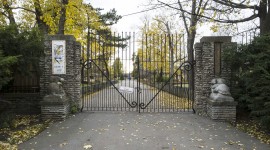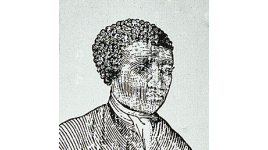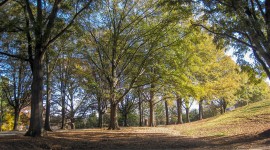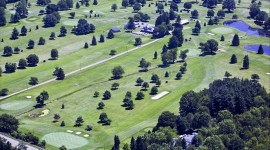It Takes One: Everett Fly, FASLA
My original aspiration was to become a professional architect. But by the time I reached my third year of undergraduate architecture school, I began to realize how important the environment and land were to creating a whole architectural composition. I decided to combine the two disciplines through the graduate study of landscape architecture. My philosophical perspective on cultural landscapes is heavily influenced from studying directly under John Brinckerhoff Jackson at the Harvard Graduate School of Design. It was at this same time that I began to recognize that African American cultural landscapes were seriously neglected and deliberately destroyed due to racial discrimination. Most nineteenth-century black communities were composed of vernacular buildings and landscapes. These are too frequently considered insignificant because they do not conform to classical design styles and philosophies. Additionally, they are not considered to be authentic because specific records, drawings, or deeds, are limited in quantity and availability.
I believe that vernacular landscapes can have as much practical value and significance as classical and designed landscapes. I use my interdisciplinary architectural and landscape architectural practice to interpret and translate historical resources for actual planning, design, and project implementation. During the first three centuries of New World settlement, most black contributions in building were limited to trades and crafts. However, there have been many significant contributions by black carpenters, blacksmiths, masons, mechanics, horticulturists, and gardeners in designed and vernacular buildings and landscapes. Sometimes this means interpreting the documentation to support formal historic designation such as the National Register of Historic Places. Other situations call for analyzing the eclectic origins of a physical technique or pattern so it may be faithfully preserved, replicated, or expressed in a contemporary composition. I engage the humanities (history, literature, folklore, civil rights, religion) to cross-reference the geography and ways people live and build on the land.

Q: How do you define a cultural landscape?
I define a cultural landscape as a place whose shape, form, components, use, or significance has been influenced by human society or a way of life. The rituals, traditions, and customs of people are expressed in many ways and become layered on the land. Some expressions and layers, such as legal land subdivision systems and sacred designations, are intellectual. Other expressions, such as roads, settlements, and towns, are physical. Some are subtle, and others are obviously pronounced. When intellectual and physical expressions of culture are combined, their significance is elevated. When different groups assign some significance to the same places or landmarks over time, those sites become even more important cultural landscapes.
Q: You studied architecture as an undergraduate student at the University of Texas. What led you to continue your studies in landscape architecture at the Harvard Graduate School of Design?
During my third year in architecture design, the professors began to add site plans to the projects. I did not know how to formally address the environmental issues, so I asked my professor, Gerlinde Leiding, for suggested reading. Her list included Ian McHarg’s Design with Nature, Garret Eckbo’s Landscape for Living, Lawrence Halprin’s The RSVP Cycles, and Landscape Architecture Magazine. I began to read these from the architecture school library and buy other works for my own reference shelf. Even though it was not required by my instructors, I continued to incorporate landscape design concepts into my studio projects each successive year. Each time I was required to make a presentation, I proposed an architectural plan and an integrated landscape architectural plan. Of course, the jury members noticed this and began to encourage me to continue my academic study of landscape architecture.
Q: How do you choose your projects?
Generally, most of the projects choose me. Most of my projects come to me by referral. One client tells another about their experiences or products from my work and suggests that I be contacted. But, I review each request with my work partner, Ellen P. Hunt, AIA Architect. We do ask whether our goals match the project goals and objectives of the client. We ask whether the client is willing to cooperate with a diverse set of stakeholders. It is also very important for the client to understand the level of difficulty and to commit to a professional process.
Q: Please discuss the overlap—to the extent that there is overlap—between being a landscape architect and a historian.
Clearly, I am a landscape architect and architect. I do not classify or advertise myself as a “historian” because there are important aspects of that discipline in which I have no credentials. But, I do claim to be a historic preservationist. So that is where the interdisciplinary overlap presents itself for me. I believe that every site has a history, including a natural and environmental history. It seems that, too often, planners and designers assume that the most recent and obvious history is the only significant history.
Q: The professional practice of architecture or landscape architecture was not historically inclusive with regards to race and gender. Do you think current practitioners are doing enough to ensure diversity and representation?
The current, tragic wave of race-related fear and violence moving across America underscores the difficult and complex nature of race in our country. I know first-hand that vestiges of old practices, and manifestations of new forms of institutional and systematic racism and sexism, still exist in all aspects of American life and culture, including landscape architecture and architecture. Understandably, the level of commitment and effort to diversity does not seem to be consistent from one state to another. As we move forward, it will be necessary to dramatically improve communications and behavior among groups on a daily basis. We cannot expect to make significant advances through occasional meetings. So, on the whole, I do not believe that current practitioners are doing enough to ensure diversity and representation.

Q. In your opinion, what are the advantages and disadvantages of the existing systems used to document and record historic places (HABS/HALS, the National Register & National Historic Sites, local inventories)?
I believe that the major advantage of existing documentation and recording systems is that they provide standards that serve the test of time. I believe that the disadvantage in these systems is the human factor. There are not enough people with broad expertise to apply the standards appropriately to a wide variety of cultural resources. Unfortunately, many professional schools do not have the financial resources and staff expertise to expose students to gender and ethnic related resources. As a result, the students enter the work force under the assumption that only designed buildings and landscapes are historically significant. In addition, the students are taught that buildings and landscapes cannot be significant if they were not designed by academically trained architects and landscape architects. Once in the workplace, the administrators of these systems rarely are required to take any continuing education that disproves the discriminatory myths. Within the past five years, I have had first-hand experience with consultants and governmental staff who had limited expertise with African American resources, yet have authority to declare them not significant enough for historic designation.
Q: You were awarded the National Humanities Medal by President Obama in 2014 for your efforts to preserve the integrity of African American places and landmarks. How has that recognition impacted your work?
Needless to say, the award of the National Humanities Medal is an astonishing honor. The Presidential and National Endowment for the Humanities recognition has validated the legitimacy of my work and the significance of African American historic resources. Someone e-mailed a request for consultation on an amazing project before I could get home from the award ceremonies. I also understand that recognition such as this comes with an enormous amount of responsibility. I have received more requests to explain my work. I try to respond to all of these as quickly as possible. I also had the opportunity to be introduced to the other award recipients who are doing amazing things with their work. So I now have a new set of opportunities for collaboration.
Q: What are some of the challenges you encounter when researching properties that are significant to African American culture and heritage?
In every part of America, there are always large gaps in public records and documentation of African American land transactions. The records that are available are usually scattered among several libraries, archives, and private collections. And there is little documentation of the thoughts and philosophies that guided the development of the physical landscape. Most communities have multiple accounts of African American social history, but very little on the physical development of buildings, sites, and neighborhoods. And there is usually little or no comparison between physical development in other communities around the United States. I usually have to begin from scratch and rely on my database for contextual comparison.
Q: Have you discovered any caches of useful information that other historians may be interested in knowing about?
There are no undiscovered stockpiles of documentation for African American cultural landscapes. The information remains extremely fragmented. Documented interpretation is usually limited. It is important to remember that the oral tradition was, and remains, very strong in the African American culture. I cannot count the number of times that an interview with a mature or elderly Black person has provided a lead not found in a written bibliography or documents index.
Q: Are there examples of architectural concepts or sites you would like to share that exemplify unrecognized contributions by African Americans to the American design vernacular?
There have been many significant contributions by black carpenters, blacksmiths, masons, mechanics, horticulturists, and gardeners in designed and vernacular buildings and landscapes. These tradespeople and craftspeople were very creative and eclectic in planning and building their homes, churches, and landscapes. Discrimination and lack of funds generally restricted African Americans to use local and native materials. In other words, Black communities had to apply sustainable practices long before the current movement to do so. These traditions and customs are usually studied as folk culture, but there is much more to them.
Q. What is the message that you would like to give our readers that may inspire them to make a difference?
America is endowed with a vast and complex history and culture. Our culture cannot be thoroughly or authentically represented if we do not diversify our knowledge of vernacular and cultural landscapes. Amazing discoveries remain to be made.












